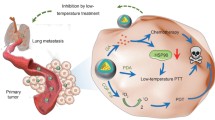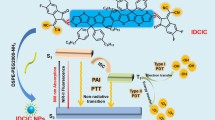Abstract
A donor-acceptor covalent organic framework (COF), TB-COF, constructed from an electron-rich building unit (donor) and an electron-deficient building unit (acceptor), was developed as a promising photothermal agent for photothermal therapy (PTT). Upon laser irradiation, significant photoinduced electron transfer (PET) occurs between the donor and acceptor in TB-COF, converting the absorbed optical energy to thermal energy and resulting in the ablation of tumor. TB-COF possessed satisfying photothermal conversion efficiency, reaching 43.65%, similar to materials commonly used for PTT. Moreover, hyaluronic acid (HA) was coated on TB-COF to improve its biocompatibility and achieve tumor targeting. Furthermore, in vitro and in vivo experiments confirmed satisfying photothermal anticancer efficacy of TB-COF-HA.

摘要
我们设计合成了一例共价有机框架材料(TB-COF), 并将其开发应用为癌症的光热治疗试剂. TB-COF是基于供体-受体原理, 由富电子构建单元(供体)和缺电子构建单元(受体)构建而成. 当受到激光照射时, TB-COF中供体和受体之间会发生显著的光诱导电子转移, 将吸收的光能转化为热能并用于肿瘤消融. TB-COF具有优异的光热转换效率, 其值可达43.65%, 与常用的光热试剂相当. 此外, 我们还将透明质酸(HA)包覆在TB-COF上, 以提高其生物相容性并实现肿瘤靶向功能. 体外和体内实验均证实了TB-COF-HA高效的光热抗癌功能.
Similar content being viewed by others
References
Shang D, Yu Q, Liu W, et al. Enhanced porphyrin-based fluorescence imaging-guided photodynamic/photothermal synergistic cancer therapy by mitochondrial targeting. Sci China Mater, 2021, 65: 527–535
Tao W, Ji X, Xu X, et al. Antimonene quantum dots: Synthesis and application as near-infrared photothermal agents for effective cancer therapy. Angew Chem Int Ed, 2017, 56: 11896–11900
Li X, Lovell JF, Yoon J, et al. Clinical development and potential of photothermal and photodynamic therapies for cancer. Nat Rev Clin Oncol, 2020, 17: 657–674
Kumari S, Sharma N, Sahi SV. Advances in cancer therapeutics: Conventional thermal therapy to nanotechnology-based photothermal therapy. Pharmaceutics, 2021, 13: 1174
Ma H, Xue M. Recent advances in the photothermal applications of two-dimensional nanomaterials: Photothermal therapy and beyond. J Mater Chem A, 2021, 9: 17569–17591
Chen Q, He S, Zhang F, et al. A versatile Pt-Ce6 nanoplatform as catalase nanozyme and NIR-II photothermal agent for enhanced PDT/PTT tumor therapy. Sci China Mater, 2020, 64: 510–530
de Melo-Diogo D, Pais-Silva C, Dias DR, et al. Strategies to improve cancer photothermal therapy mediated by nanomaterials. Adv Healthc Mater, 2017, 6: 1700073
Wang J, Wu X, Shen P, et al. Applications of inorganic nanomaterials in photothermal therapy based on combinational cancer treatment. Int J Nanomed, 2020, Volume 15: 1903–1914
Jung HS, Lee JH, Kim K, et al. A mitochondria-targeted cryptocyanine-based photothermogenic photosensitizer. J Am Chem Soc, 2017, 139: 9972–9978
Liu SW, Wang L, Lin M, et al. Tumor photothermal therapy employing photothermal inorganic nanoparticles/polymers nanocomposites. Chin J Polym Sci, 2018, 37: 115–128
Zou Q, Abbas M, Zhao L, et al. Biological photothermal nanodots based on self-assembly of peptide-porphyrin conjugates for antitumor therapy. J Am Chem Soc, 2017, 139: 1921–1927
Wang Y, Meng HM, Song G, et al. Conjugated-polymer-based nano-materials for photothermal therapy. ACS Appl Polym Mater, 2020, 2: 4258–4272
Yang Y, Zhu W, Dong Z, et al. 1D coordination polymer nanofibers for low-temperature photothermal therapy. Adv Mater, 2017, 29: 1703588
Feng X, Ding X, Jiang D. Covalent organic frameworks. Chem Soc Rev, 2012, 41: 6010–6022
Hou Q, Wu Y, Zhou S, et al. Ultra-tuning of the aperture size in stiffened ZIF-8_mm frameworks with mixed-linker strategy for enhanced CO2/CH4 separation. Angew Chem Int Ed, 2019, 58: 327–331
Wang H, Zeng Z, Xu P, et al. Recent progress in covalent organic framework thin films: Fabrications, applications and perspectives. Chem Soc Rev, 2019, 48: 488–516
Guan X, Chen F, Fang Q, et al. Design and applications of three dimensional covalent organic frameworks. Chem Soc Rev, 2020, 49: 1357–1384
Cai L, Hu C, Liu S, et al. A covalent organic framework-based multifunctional therapeutic platform for enhanced photodynamic therapy via catalytic cascade reactions. Sci China Mater, 2021, 64: 488–497
Kandambeth S, Dey K, Banerjee R. Covalent organic frameworks: Chemistry beyond the structure. J Am Chem Soc, 2019, 141: 1807–1822
Zhang L, Wang S, Zhou Y, et al. Covalent organic frameworks as favorable constructs for photodynamic therapy. Angew Chem Int Ed, 2019, 58: 14213–14218
Zeng JY, Wang XS, Xie BR, et al. Covalent organic framework for improving near-infrared light induced fluorescence imaging through two-photon induction. Angew Chem Int Ed, 2019, 59: 10087–10094
Huang N, Wang P, Jiang D. Covalent organic frameworks: A materials platform for structural and functional designs. Nat Rev Mater, 2016, 1: 16068
Segura JL, Royuela S, Mar Ramos M. Post-synthetic modification of covalent organic frameworks. Chem Soc Rev, 2019, 48: 3903–3945
Zhang G, Li X, Liao Q, et al. Water-dispersible PEG-curcumin/amine-functionalized covalent organic framework nanocomposites as smart carriers for in vivo drug delivery. Nat Commun, 2018, 9: 2785
Zhang J, Yang C, Zhang R, et al. Biocompatible D-A semiconducting polymer nanoparticle with light-harvesting unit for highly effective photoacoustic imaging guided photothermal therapy. Adv Funct Mater, 2017, 27: 1605094
Lyu Y, Zeng J, Jiang Y, et al. Enhancing both biodegradability and efficacy of semiconducting polymer nanoparticles for photoacoustic imaging and photothermal therapy. ACS Nano, 2018, 12: 1801–1810
Guo B, Feng G, Manghnani PN, et al. A porphyrin-based conjugated polymer for highly efficient in vitro and in vivo photothermal therapy. Small, 2016, 12: 6243–6254
MacNeill CM, Coffin RC, Carroll DL, et al. Low band gap donor-acceptor conjugated polymer nanoparticles and their NIR-mediated thermal ablation of cancer cells. Macromol Biosci, 2013, 13: 28–34
Lyu Y, Fang Y, Miao Q, et al. Intraparticle molecular orbital engineering of semiconducting polymer nanoparticles as amplified ther-anostics for in vivo photoacoustic imaging and photothermal therapy. ACS Nano, 2016, 10: 4472–4481
Jiang Q, Luo Z, Men Y, et al. Red blood cell membrane-camouflaged melanin nanoparticles for enhanced photothermal therapy. Biomaterials, 2017, 143: 29–45
Yu T, Malugin A, Ghandehari H. Impact of silica nanoparticle design on cellular toxicity and hemolytic activity. ACS Nano, 2011, 5: 5717–5728
Mazzarino L, Loch-Neckel G, Dos Santos Bubniak L, et al. Nano-particles made from xyloglucan-block-polycaprolactone copolymers: Safety assessment for drug delivery. Toxicol Sci, 2015, 147: 104–115
Acknowledgements
This work was supported by the National Natural Science Foundation of China (22104074, 22274089, and 21965011), the Natural Science Foundation of Shandong Province (ZR2022YQ10 and ZR2020QB106), the Local Science and Technology Development Fund Guided by the Central Government (YDZX20203700002568), the Natural Science Foundation of Hainan Province (220RC458), and the Major Science and Technology Plan of Hainan Province (ZDKJ202016).
Author information
Authors and Affiliations
Contributions
Author contributions Tang B, Li N, and Gao Y designed the study and supervised the project; Wan X, Zhang J, and Zuo K conceived the experimental scheme and performed the experiments; Zhang J and Zhang H carried out the in vitro and in vivo experiments; Wan X, Zhang J, Zuo K, and Hu H performed data analysis; Wan X wrote the paper with support from Pan W. All authors contributed to the general discussion.
Corresponding authors
Ethics declarations
Conflict of interest The authors declare that they have no conflict of interest.
Additional information
Supplementary information Experimental details and supporting data are available in the online version of the paper.
Xiuyan Wan received her PhD degree in inorganic chemistry from Fujian Institute of Research on the Structure of Matter, Chinese Academy of Sciences. She is now an associate professor and master supervisor at Shandong Normal University. Her research mainly focuses on MOF- and COF-based materials and their applications in cancer therapy.
Bo Tang obtained his PhD degree in analytical chemistry in 1994 from Nankai University. Then he joined the College of Chemistry, Chemical Engineering and Materials Science as a full professor at Shandong Normal University. His current research interests include the development of molecular and nanoprobes for analytical and biomedical applications, solar energy chemical transformation and storage, and clean synthesis of chemicals.
Rights and permissions
About this article
Cite this article
Wan, X., Zhang, J., Zuo, K. et al. A donor-acceptor covalent organic framework as the promising construct for photothermal therapy. Sci. China Mater. 66, 1227–1236 (2023). https://doi.org/10.1007/s40843-022-2232-4
Received:
Accepted:
Published:
Issue Date:
DOI: https://doi.org/10.1007/s40843-022-2232-4




